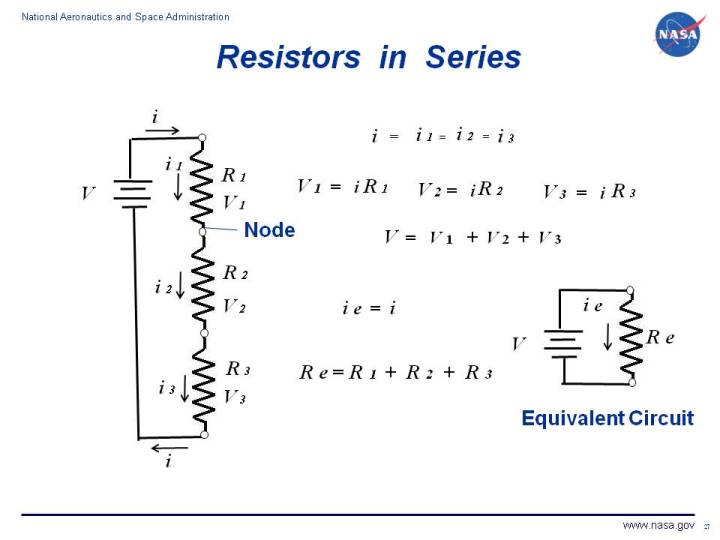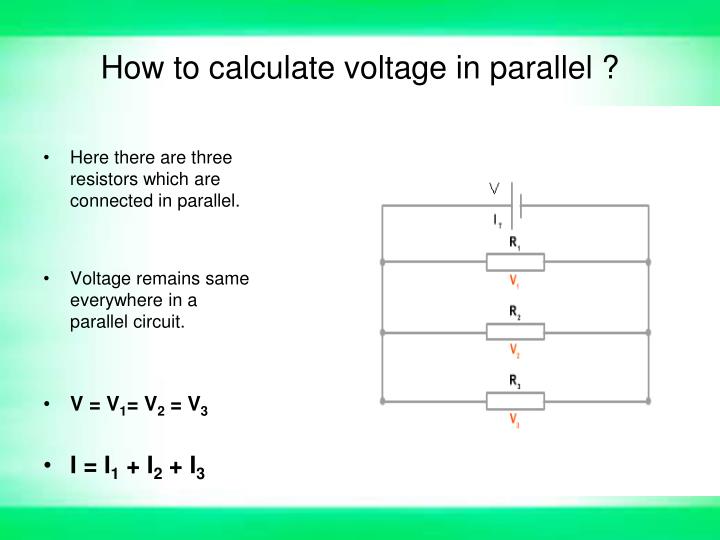The Secret Of Info About Why Does Voltage Stay The Same When Resistance Increases

Voltage In Parallel Current At Thelma Guerrero Blog
Voltage, Resistance, and That Constant Conundrum
1. Understanding the Basics
Okay, let's tackle this head-on: why does voltage sometimes seem to stubbornly stay put, even when we crank up the resistance? It's a question that's tripped up many a budding electrician (and probably a few seasoned ones, too, if we're being honest!). The key lies in understanding the specific setup we're dealing with. Think of it like this: a water faucet is like a voltage source, and the pipe is the resistance. Turning the faucet on full blast is like setting a constant voltage.
Now, imagine you're pinching the water pipe that's like increasing the resistance. If the faucet (voltage source) keeps pumping water at the same pressure (voltage), it doesn't matter how much you pinch the pipe; the pressure at the faucet remains relatively constant, but the amount of water flowing through decreases. This is a simplified analogy, but it helps visualize what's happening in an electrical circuit with a constant voltage source.
The critical phrase here is "constant voltage source." If you have a battery, for example, that's designed to deliver a specific voltage, it will try its darnedest to maintain that voltage, even if you increase the resistance in the circuit. It does this by adjusting the current flowing through the circuit. This relationship is elegantly described by Ohm's Law: V = IR (Voltage = Current x Resistance). So, if V is constant and R increases, then I must decrease!
Think of it like a stubborn friend who insists on paying the entire bill, no matter how much you argue. They'll find a way to make it happen! A constant voltage source is similar; it's committed to maintaining that voltage level, come what may. But, of course, even the most steadfast battery will eventually give out if you ask too much of it! The voltage source will have limits on how much current it can provide. Beyond these limits, the voltage may drop.

Flujo De Corriente En Un Circuito Serie Con Dos Fuentes Voltaje
Constant Voltage Source
2. Delving Deeper into Voltage Sources
To really nail this down, we need to focus on the concept of a "constant voltage source." This isn't just any old battery; it's a power supply that's specifically designed to maintain a consistent voltage output. These sources often have internal mechanisms to compensate for changes in resistance. They're the unsung heroes of electronics, quietly ensuring that your devices get the power they need.
Imagine you have a power supply for your computer. As you open more programs, the computer's resistance effectively decreases (it's drawing more power). A constant voltage source will automatically increase the current it provides to keep the voltage steady. Without this, your computer would brown out every time you tried to multitask. Thank you, constant voltage source!
However, it's important to remember that even the best constant voltage source has its limitations. There's a maximum current it can supply. If you increase the resistance beyond a certain point (or, conversely, decrease it too much, drawing excessive current), the voltage source won't be able to keep up. At this point, the voltage will start to drop. It's like trying to pour water faster than the faucet can deliver; eventually, the water pressure decreases.
Consider a bench power supply in a lab setting. These are typically constant voltage, constant current sources. You can dial in a specific voltage, and the power supply will maintain it (within its limits) regardless of the load you connect. But if you try to draw too much current, it will switch to constant current mode, and the voltage will drop to protect the power supply from damage. It's a safety feature, and a reminder that nothing is truly "constant" in the real world.

What Is The Voltage Drop In Resistor R2 Series Circuit Wiring Diagram
Ohm's Law
3. Putting the Equation to Work
Let's revisit Ohm's Law: V = IR. This seemingly simple equation is the foundation of understanding how voltage, current, and resistance interact. If voltage (V) is held constant, and resistance (R) increases, then current (I) must decrease. This is the only way the equation can remain balanced. Its a fundamental principle, and it's always at play, whether you realize it or not.
Think of it like a seesaw. Voltage is the fulcrum, and current and resistance are sitting on either end. If you increase the resistance on one side, the current on the other side has to decrease to keep the seesaw balanced. If the fulcrum (voltage) moves to a fixed point and the resistance changes, the current changes, this maintains the balance!
A common misconception is that increasing resistance always causes voltage to drop. This is only true if the current is forced to remain constant or increases. If you have a fixed current source, increasing resistance will cause the voltage to increase. But if your voltage is constant, any change in resistance leads to a change in current to maintain that voltage value. This is the key concept to hold in mind as you analyze circuits.
So, the next time you're tinkering with a circuit and wondering why the voltage isn't changing despite your fiddling with the resistance, remember Ohm's Law. It's your guiding star, your constant companion in the world of electronics. By understanding this relationship, you can predict how a circuit will behave and troubleshoot any problems that arise. It's really that simple (though the applications can get pretty complex!).

If Voltage Remains The Same And Resistance Increases
Real-World Scenarios
4. Applying the Concepts
Let's consider some real-world examples to solidify our understanding. Think about the power outlet in your wall. It's designed to provide a relatively constant voltage (120V in the US, 230V in Europe). When you plug in a lamp, you're adding resistance to the circuit. The power company has to respond to maintain a constant voltage at the outlet. It will increase current into your home to keep voltage consistent!
Now, what happens if everyone in your neighborhood turns on their air conditioners on a hot summer day? The power grid becomes heavily loaded, and the power company struggles to keep up with the demand. The resistance effectively decreases as more devices draw power. This can lead to a slight voltage drop, which you might notice as dimming lights. This is because the power grid is no longer able to perfectly maintain a constant voltage under such heavy load.
Another example is a car's electrical system. The alternator is designed to maintain a constant voltage to charge the battery and power the car's accessories. However, if you turn on all the lights, the radio, and the air conditioning at the same time, you might notice a slight drop in voltage. The alternator is working hard to keep up, but it has its limits. It's another illustration of the principle that even "constant" voltage sources have boundaries.
Contrast this with a voltage divider circuit, where the voltage is divided proportionally based on the resistors in the circuit. In a voltage divider, if you change one of the resistors, the output voltage will change. This is because there's no constant voltage source actively trying to maintain a specific voltage level at the output. The voltage is simply a function of the resistor values. That is very different from a power supply!

Beyond the Ideal
5. The Imperfect Reality
It's essential to understand that the concept of a "constant" voltage source is an idealization. In the real world, no voltage source is perfectly constant. There will always be some degree of fluctuation, depending on the load, the source's internal impedance, and other factors. These fluctuations are usually small, but they can be significant in sensitive applications.
Consider a battery. As it discharges, its voltage gradually decreases. This is because the chemical reactions inside the battery are slowing down, and it's no longer able to maintain the same voltage level. Even a brand-new battery will exhibit some voltage drop when placed under load. This is due to the battery's internal resistance, which causes a voltage drop when current flows through it. So, even though the battery is trying to maintain a constant voltage, its internal limitations prevent it from being perfect.
Furthermore, the temperature can affect the performance of voltage sources. For example, the voltage of a solar panel decreases as its temperature increases. This is because the increased temperature increases the internal resistance of the solar cell, reducing its efficiency. So, even if the sunlight is constant, the voltage output will vary depending on the temperature.
So, while the concept of a constant voltage source is a useful abstraction for understanding circuit behavior, it's important to remember that it's not a perfect representation of reality. The "constant" voltage is more like a target or a goal that the voltage source is trying to achieve, but it will always be subject to some degree of variation due to the limitations of the physical components involved.

FAQ
6. Q
A: If you increase the resistance to a very high level, the current will decrease to a very low level. However, the voltage will remain constant until the resistance becomes so high that it approaches an open circuit. At this point, the current will be nearly zero, and the voltage source will essentially be unloaded, maintaining its nominal voltage.
7. Q
A: Yes, the same general principles apply to AC circuits. However, in AC circuits, we deal with impedance instead of resistance, which includes both resistance and reactance (due to capacitors and inductors). A constant voltage AC source will still try to maintain a constant voltage amplitude, even as the impedance changes. But phase shifts also occur.
8. Q
A: That's correct. In the real world, no voltage source is perfectly constant. There will always be some degree of voltage fluctuation, depending on factors like load, temperature, and the source's internal impedance. However, a good constant voltage source will minimize these fluctuations and maintain the voltage within a specified tolerance range. So, it's more accurate to think of them as relatively constant voltage sources.